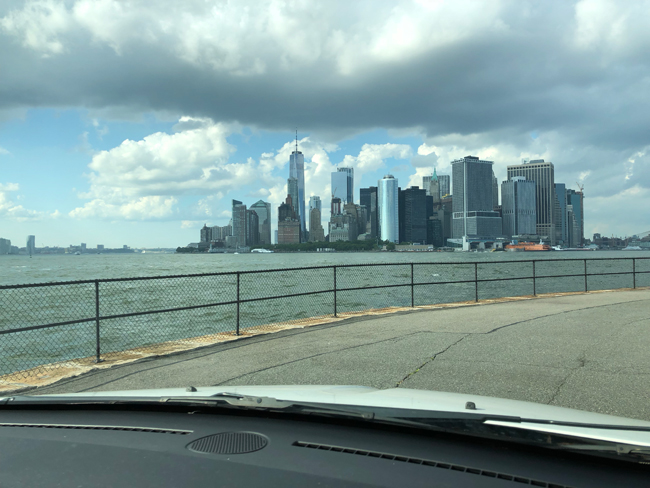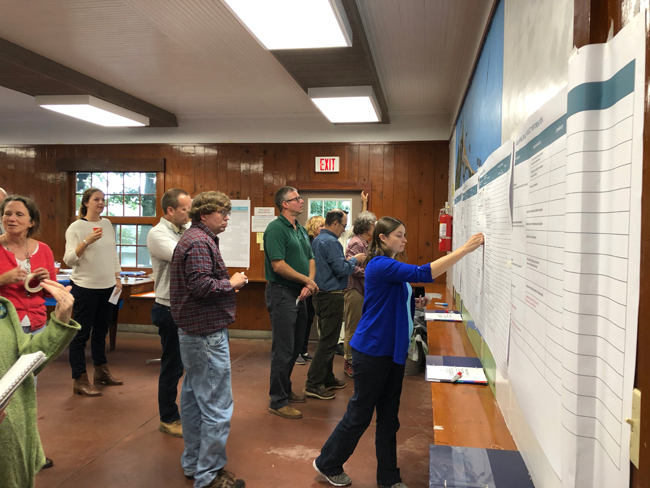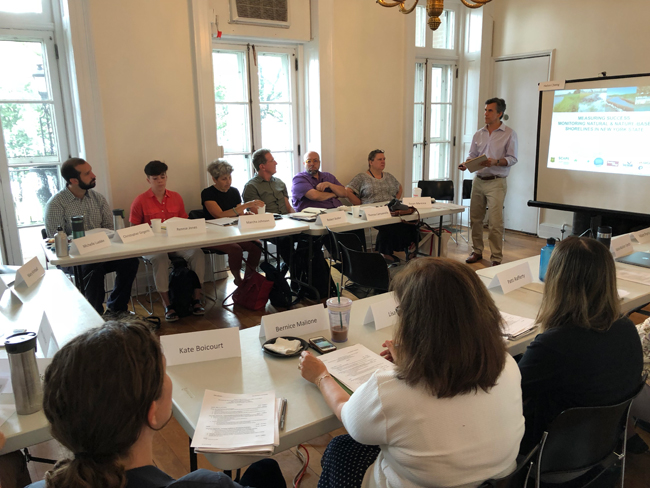
New York City is among one of four regions identified by the Nature Based-Shorelines Project. Credit: Helen Cheng
New York Sea Grant’s Coastal Specialists Serve as Regional Stakeholder Engagement Leads on NOAA and NYSERDA-Funded Nature-Based Shorelines Project
Contacts:
- Helen Cheng, Coastal Resilience Specialist,
E: helen.cheng@cornell.edu, P: (718) 951-5415
- Kathleen Fallon, Marine District Coastal Processes & Hazards Specialist, NYSG,
E: kmf228@cornell.edu, P: (631) 632-8730
- Roy Widrig, Great Lakes Coastal Processes and Hazards Specialist,
E: rlw294@cornell.edu, P: (315) 312-3042
- Amanda Stevens, Project Manager, NYSERDA (co-sponsor),
E: Amanda.stevens@nyserda.ny.gov
- Carolyn Fraioli, Project Manager, Climate Change & Resilience Unit, NYS DOS (co-sponsor),
E: Carolyn.fraioli@dos.ny.gov, P: (518) 474-6000
New York, NY, January 25, 2019 – A new framework is being developed to monitor and evaluate the performance of nature-based shorelines throughout New York State. The effort — via a partnership between the New York State (NYS) Department of State’s (DOS) Office of Planning, Development & Community Infrastructure and the New York State Energy Research & Development Authority (NYSERDA) — includes exploring the best ways to evaluate the function of wetlands, natural materials such as beach grass plantings, and nature-based features such as living shorelines. It also examines the use of concrete walls, rock revetments, and other manmade structures to provide multiple benefits—such as social, ecological and physical shoreline stabilization.
The Nature-Based Shorelines Project is managed and co-sponsored by NYS DOS and NYSERDA. Project collaborators includes the Science and Resilience Institute at Jamaica Bay (SRIJB) (lead), New York Sea Grant (NYSG), ARCADIS, City University of New York, NY-NJ Harbor Estuary Program, NYC Department of Parks and Recreation, NYS Department of Environmental Conservation, SCAPE Landscape Architecture, the Consensus Building Institute and the US Forest Service-NYC Urban Field Station.
In collaboration with these institutions and organizations, NYSG is assisting in the development of a framework that will help coastal communities better understand the performance of different shoreline management measures on NYS’s Great Lakes, Hudson River, and ocean shorelines. Sea Grant is able to provide a statewide perspective on the project, with personnel, relationships, and partnerships throughout the State.
NYSG staff served as workshop leads for the Great Lakes, New York City, and Long Island regions. The specialists’ roles were to invite key stakeholders — waterfront practitioners, scientists, and others with expertise in area waters and organized workshops in their respective regions — to provide feedback on the natural and nature-based features monitoring framework as well as discuss the nuances of shoreline management in each region. The specialists helped facilitate conversations among stakeholders at the regional level, including an overview of the three themes of indicators and parameters related to determining the success of shoreline features such as nature-based shorelines. These themes included ecological function, hazard mitigation and structural integrity, as well as socio-economic outcomes. The feedback received at each workshop will be incorporated into the final version of the monitoring framework.

Bennett Brooks, from the Consensus Building Institute, co-led the implementation of all four regional workshops during the Summer 2018. Credit: Helen Cheng
Project Manager Carolyn Fraioli, who works as a Coastal Resources Specialist at DOS, stressed: “This project is important in helping to improve our understanding of the performance and benefits of different shoreline treatments. Much of the success of the project thus far is due to the outstanding collaboration between project team members and broad engagement of stakeholders, which is essential in informing the final framework.”

Workshop participants in the Great Lakes region give input on the Living Shorelines project framework. Credit: Helen Cheng
Roy Widrig, NYSG’s Great Lakes Coastal Processes and Hazards Specialist at SUNY Oswego, is the lead for the Great Lakes Region and says man-made management efforts function best in concert with the natural environment.
“This monitoring project will provide insights on how we can best apply nature-based features to adapt more responsibly and effectively to the changing climate,” said Widrig.
Helen Cheng, NYSG and SRIJB’s Coastal Resilience Specialist, is the regional lead for the New York City region.
Cheng noted that although there’s plenty of optimism, nature-based shorelines strategies are still new, and there is further study needed to explain how nature-based features might reduce risk and provide ecological and community benefits.
“A lot of people say that ‘natural shorelines are great.’ But why are they great, and where are they great?” said Cheng. “This project takes a look at that. I think this project will help provide a strong foundation of research and support for shoreline practices.”

Helen Cheng, the regional lead for the New York City Region, invited stakeholders to participate in discussions at the NYC workshop. Credit: Helen Cheng
Kathleen Fallon, NYSG’s Coastal Process and Hazards Specialist at Stony Brook University, is also a regional workshop lead on this project.
“A lot of Long Island’s shoreline is privately owned, which is an important nuance to consider because that isn’t the case in every region,” said Fallon. “Getting input from all four regions is essential when creating a product that is really beneficial statewide.”
Fallon also notes that the project will be particularly useful for Long Island, which does not have a history of landowner investment in nature-based shorelines.
“I’ve spoken to some homeowners in the past where they have identified an erosion issue on their property and said to me: ‘I don’t really want to put in a bulkhead, what are my other options?’ said Fallon. “This project will help inform them of different options they can take. I think it’s really great this project is broadening and furthering the use of nature-based features on Long Island.”
Funding for a portion of the project, which includes testing the framework at pilot locations in the Great Lakes, Hudson Valley, Long Island, and New York City areas, come from a National Oceanic and Atmospheric Administration grant that was awarded to NYS DOS. A final monitoring framework is expected to be completed by September 2019. Project information will be made available on the DOS Office of Planning, Development & Community Infrastructure website.
— Additional writing by Kara Dunn, NYSG's Great Lakes publicist
More Info: New York Sea Grant
New York Sea Grant (NYSG), a cooperative program of Cornell University
and the State University of New York (SUNY), is one of 33 university-based
programs under the National Oceanic and Atmospheric Administration’s
National Sea Grant College Program.
Since 1971, NYSG has represented a statewide network of integrated
research, education and extension services promoting coastal community
economic vitality, environmental sustainability and citizen awareness
and understanding about the State’s marine and Great Lakes resources.
Through NYSG’s efforts, the combined talents of university scientists
and extension specialists help develop and transfer science-based
information to many coastal user groups—businesses and industries,
federal, state and local government decision-makers and agency managers,
educators, the media and the interested public.
The program maintains Great Lakes offices at Cornell University, SUNY
Buffalo, SUNY Oswego and the Wayne County Cooperative Extension office
in Newark. In the State's marine waters, NYSG has offices at Stony Brook
University in Long Island, Brooklyn College and Cornell Cooperative
Extension in NYC and Kingston in the Hudson Valley.
For updates on Sea Grant activities: www.nyseagrant.org has RSS, Facebook, Twitter, and YouTube links. NYSG offers a free e-list sign up via www.nyseagrant.org/nycoastlines for its flagship publication, NY Coastlines/Currents, which is published quarterly. Our program also produces an occasional e-newsletter,"NOAA Sea Grant's Social Media Review," via its blog, www.nyseagrant.org/blog.